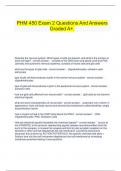Exam (elaborations)
PHM 450 Exam 2 Questions And Answers Graded A+.
PHM 450 Exam 2 Questions And Answers Graded A+.
Describe .the .nervous .system. .What .types .of .cells .are .present, .and .what .is .the .function .of .each .cell .type? .- .correct .answer. . . . .consists .of .the .CNS .(brain .and .spinal .cord) .and .PNS .(somatic .and .aut...
[Show more]
Preview 3 out of 24 pages
Uploaded on
August 23, 2024
Number of pages
24
Written in
2024/2025
Type
Exam (elaborations)
Contains
Questions & answers
phm 450 exam 2 questions and answers graded a
describe the nervous system what types of cells a
type of glia cell that produces myelin in the cent
Institution
PHM 450
Course
PHM 450
$12.49
100% satisfaction guarantee
Immediately available after payment
Both online and in PDF
No strings attached
PHM 450 Exam 2 Questions And Answers




